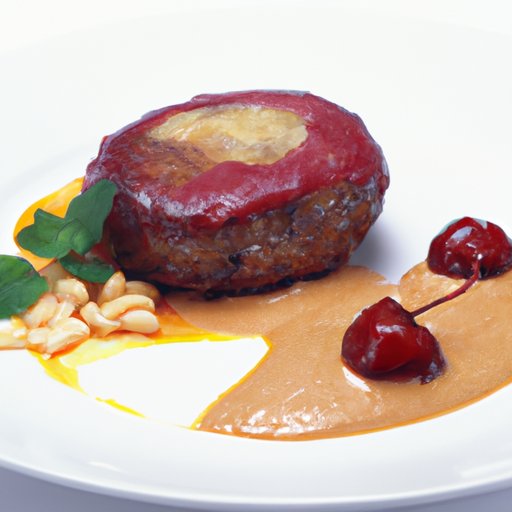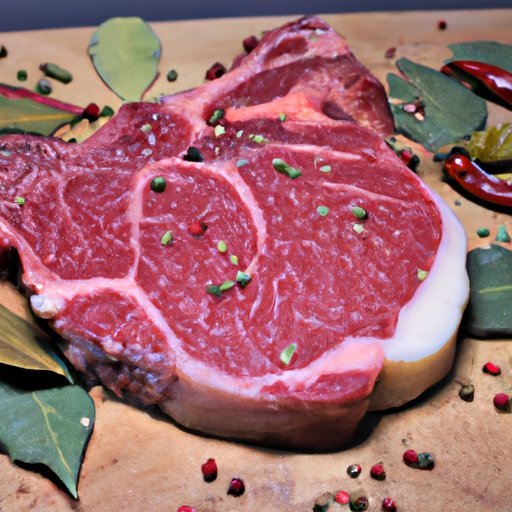I. Introduction
Veal meat is a specialty meat known for its tenderness and delicate flavor. However, it is often associated with unethical farming practices and controversy surrounding its consumption. In this article, we will explore everything you need to know about veal meat, from its nutritional value to its culinary uses and ethical considerations.
A. Definition of Veal Meat and Common Misconceptions
Veal meat is the meat from young calves that are usually less than three months old. The meat has a tender texture and a pale pink color. There is a common misconception that all veal comes from calves that are raised in cramped conditions and separated from their mothers. While there are some farms that follow these unethical practices, there are also farms that raise calves in humane conditions.
B. Importance of Understanding Veal Meat for Food Enthusiasts
For food enthusiasts, understanding the nuances of different types of meats is essential to expanding one’s culinary horizons. Veal meat is a specialty meat that can be prepared in a variety of ways, and its delicate flavor can be complemented by a wide range of ingredients and cooking techniques.
II. The Lowdown on Veal Meat: A Complete Guide for Food Enthusiasts
A. Types of Veal Meat
There are two main types of veal meat: milk-fed veal and pasture-raised veal. Milk-fed veal is raised on a diet of milk or milk replacer and is typically very pale in color. Pasture-raised veal is raised on a diet of solid food such as hay and grass, and has a slightly darker color and a more robust flavor.
B. Nutritional Value of Veal Meat
Veal meat is a good source of protein, essential vitamins, and minerals. A three-ounce serving of cooked veal contains around 26 grams of protein, which is essential for building and repairing muscles. Veal meat is also rich in nutrients such as vitamin B12, iron, and zinc, which are important for maintaining overall health.
C. Culinary Uses of Veal Meat
Veal meat can be prepared in a variety of ways, such as grilling, roasting, braising, and sautéing. Its mild flavor pairs well with a range of ingredients such as herbs, spices, and vegetables. Veal meat is commonly used in classic dishes such as veal piccata and veal Marsala, but it can also be used in innovative ways such as grilled veal chops or braised veal shanks.
III. Everything You Need to Know About Veal Meat
A. History of Veal Meat and How it Became a Specialty Meat
Veal meat has been consumed in Europe for centuries and was traditionally associated with high-end cuisine. In the United States, veal meat gained popularity in the mid-twentieth century, but its consumption declined in the late 1900s due to animal welfare concerns. Today, veal meat is still considered a specialty meat and is often found on the menus of high-end restaurants.
B. Production of Veal Meat and Farming Practices
The production of veal meat involves raising calves from dairy cows. Some farms use ethical farming practices, such as group housing for calves and allowing them to have access to their mothers. However, there are also farms that use inhumane practices such as confining calves in small crates and depriving them of proper nutrition and mobility. It is important for consumers to be aware of their food sources and to choose meat that comes from farms that follow ethical practices.
C. Distribution and Availability of Veal Meat
Veal meat can be found in many grocery stores, but it is more commonly found in specialty meat markets and high-end restaurants. Veal meat is more expensive than other types of meat, but its delicate flavor and tenderness make it a popular choice for special occasions and gourmet cooking.
IV. From Farm to Plate: The Journey of Veal Meat Explained
A. Overview of the Veal Industry
The veal industry is subject to strict regulations to ensure the safety and welfare of the animals. Farms must follow guidelines for housing, nutrition, and care, and must comply with regulations related to transport and processing of veal meat.
B. Processing and Packaging of Veal Meat
After calves are raised for veal meat, they are transported to processing plants where the meat is harvested, trimmed, and packaged. The meat is then shipped to distributors, who sell it to grocery stores and restaurants.
C. Transportation and Storage of Veal Meat
Veal meat must be transported and stored at proper temperatures to prevent spoilage and ensure safety. The meat is typically stored at temperatures between 28 and 32 degrees Fahrenheit before being cooked and consumed.
V. Exploring the Ethical Debate Surrounding the Consumption of Veal Meat
A. Animal Welfare Concerns Related to Veal Farming
There are valid concerns about the treatment of calves in some veal farming operations. Some farms use inhumane practices such as keeping calves confined in small crates and depriving them of proper nutrition and mobility. In response to these concerns, some farmers have adopted more humane practices, such as group housing and allowing calves to have access to their mothers.
B. The Veal Industry’s Responses to Criticism
Many farmers and industry groups have responded to criticism by adopting more humane farming practices and promoting transparency in their operations. Some have implemented certification programs that guarantee ethical farming practices.
C. Alternative Meat Options for Ethical Consumers
For consumers who are concerned about the ethical implications of consuming veal meat, there are alternative options such as grass-fed beef, free-range chicken, and plant-based proteins. It is important to research the sources of your food to ensure that it aligns with your ethical values.
VI. The Health Benefits and Risks of Eating Veal Meat
A. Nutritional Benefits of Veal Meat
Veal meat is a good source of protein, essential vitamins, and minerals. A three-ounce serving of cooked veal contains around 26 grams of protein, which is essential for building and repairing muscles. Veal meat is also rich in nutrients such as vitamin B12, iron, and zinc, which are important for maintaining overall health.
B. Risks Associated with Consuming Veal Meat
Veal meat, like any meat, contains cholesterol and saturated fat, which can contribute to heart disease and other health problems if consumed in excess. Additionally, some studies have shown that certain environmental contaminants, such as dioxins, may accumulate in veal meat due to farming practices.
C. How to Enjoy Veal Meat in Moderation for a Balanced Diet
To enjoy the health benefits of veal meat while minimizing the risks, it is important to consume it in moderation and to choose meat from farms that follow ethical farming practices. Additionally, cooking methods that involve grilling or roasting can help to reduce excess fat and cholesterol.
VII. Pairing Wine with Veal Meat: A Guide to Elevating Your Dining Experience
A. Types of Wine that Pair Well with Veal Meat
Veal meat pairs well with a variety of wines, including light-bodied red wines such as Pinot Noir and Beaujolais, as well as white wines such as Chardonnay and Sauvignon Blanc. Additionally, sparkling wines such as Prosecco or Champagne can complement the delicate flavor of veal.
B. Tips for Selecting and Serving Wine with Veal Meat
When selecting wine to pair with veal meat, consider the preparation method and flavor profile of the dish. Richer, more robust dishes may pair well with a full-bodied red wine, while lighter dishes may require a lighter wine. Additionally, serving the wine at the appropriate temperature can enhance the flavors of both the wine and the meat.
C. Enhancing the Flavors of Veal Meat with Complementary Wines
The right wine can enhance the flavor of veal meat and elevate your dining experience. Experiment with different wine pairings to find the perfect match for your favorite veal dishes.

VIII. Veal Meat Recipes: Creative and Delicious Ways to Cook with this Specialty Meat
A. Classic Veal Recipes
Veal meat is a popular ingredient in classic dishes such as veal piccata, veal Marsala, and osso buco. These dishes typically involve braising or slow-cooking the meat until it is tender and flavorful.
B. Innovative Ways to Prepare and Cook Veal Meat
Veal meat can also be prepared in innovative ways such as grilling or pan-searing, which can bring out its delicate flavor and tender texture. Grilled veal chops, for example, can be seasoned with herbs and served with a side of roasted vegetables for a simple yet elegant meal.
C. Tips for Cooking Veal Meat to Perfection
To ensure that veal meat is cooked to perfection, it is important to use proper cooking techniques and to avoid overcooking. The temperature of the meat should be monitored to ensure that it is cooked through, but not overdone. Additionally, using high-quality ingredients and complementary flavors can bring out the best in the meat.
IX. Conclusion
A. Recap of Key Points About Veal Meat
Veal meat is a delicacy that can be prepared in a variety of ways and paired with a range of wines. It is important for consumers to be aware of the ethical considerations surrounding veal farming and to choose meat from farms that follow humane practices. Additionally, consuming veal meat in moderation can provide essential nutrients while minimizing health risks.
B. Encouragement for Readers to Try Veal Meat in New Ways
For food enthusiasts, experimenting with new ingredients and cooking techniques is essential to expanding one’s culinary horizons. Veal meat is a delicate and versatile protein that can be prepared in a variety of ways, and trying new recipes and wine pairings can make for a memorable dining experience.
C. Final Thoughts and Recommendations for Further Reading
Whether you are a culinary expert or a novice home cook, exploring the world of veal meat can be a rewarding experience. To learn more about ethical farming practices, cooking techniques, and wine pairings, we recommend doing further research and trying new recipes.
